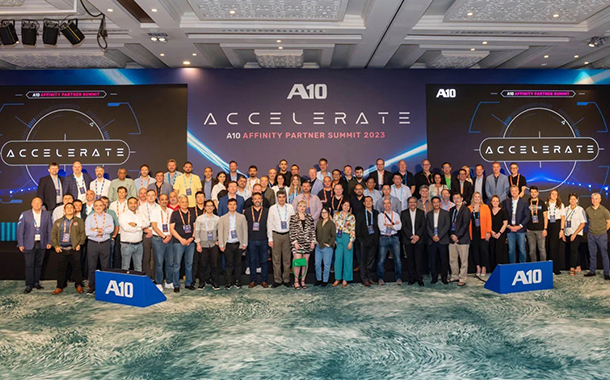A10 Networks outlined its blueprint to enable enterprises and web giants to meet the demands for the security, reliability and agility of applications in a multi-cloud world. With applications increasingly distributed across multiple clouds, and users more mobile, managing and securing applications has become more complex than ever.
This disparate infrastructure and the increased threat surface create challenges to digital transformation. A10’s Polynimbus application services blueprint offers a way forward for enterprises and web giants to bridge the gaps created by diverse application environments that need to be managed and secured. This blueprint can enable greater simplicity, agility, consistent manageability and security for organisations as they tackle the complexities of the multi-cloud world.
Today, there is an “application exodus” from traditional enterprise data centres, with applications now running across multiple clouds. This requires an effective Polynimbus operational model. Polynimbus is defined as the operations of an enterprise across two or more public clouds, and this has now become the de facto standard for application infrastructures.
In fact, according to a global survey conducted by the Business Performance Innovation Network, in partnership with A10, approximately two thirds of enterprises have deployed across two or more public clouds, with 84% expecting to increase their reliance on public or private clouds over the next 24 months. However, only 11% of companies surveyed believed they had been highly successful in realising the benefits of multi-cloud infrastructures. Security, lack of IT talent, and effectively managing the complexity are understandably listed as top challenges.
“There is also an unprecedented need for deeper visibility and real-time insights into application traffic, particularly for cloud-based applications and cloud-native environments, where dynamic and often ephemeral microservices require pervasive application-layer observability,” said Brad Casemore, IDC’s research vice president, Datacenter Networks. “Modernised Security and ADC technologies are capable of playing an integral role in helping enterprises realise the full array of multi-cloud benefits as they move to a multi-cloud, or Polynimbus, application services environment, especially in an era when applications, supported by agile and flexible application-delivery infrastructure, are more important to business success than ever before.”
A10 addresses the new multi-cloud operational reality with the Polynimbus application services blueprint. It covers secure operations considerations, the most impactful current and emerging multi-cloud technologies, migration from on-premises hardware and software to the cloud, and the requirements to ensure a successful pivot of operations across a multi-cloud environment. It is no longer a case of a few cloud architects simply deploying a couple of applications to the cloud in silos. It is a shift to managing the new reality securely and efficiently as a core reliable IT operation.
“A10 understands the myriad of challenges enterprises and web giants are facing as they enter a new phase in shifting to multi-cloud strategies,” said Lee Chen, founder and CEO of A10 Networks. “Organisations need to move beyond the early siloed deployments of cloud platforms, to adopt intelligent automation to handle the operational challenges of these systems. In this phase, organisations need to adjust their strategy to ensure the business is protected and applications are always reliable.”
A10 provides a comprehensive stack of Polynimbus application services to ensure a successful multi-cloud solution:
- Availability of services in the most prevalent form factors. Delivering cloud-specific services, for example Microsoft Azure, Oracle Cloud Infrastructure, Amazon Web Services, containers, bare metal, virtual, and hardware are table stakes in the Polynimbus application services world. With the move to a true Polynimbus operational model, organisations must plan their services migration path for the next 2-5 years to meet their operational goals.
- Multiple application services are required to perform security and reliability functions across cloud infrastructure. Services on a given cloud provider may differ widely, so Polynimbus application services must be available to ensure seamless application delivery. Representative services include advanced load balancing, web application firewall, authentication access management, malicious traffic and bot mitigation, integrated DDoS protection with real-time threat intelligence, data centre firewall, L7 application scripting, global server load balancing, TLS/SSL offload, and more.
- Flexible software licensing and consumption via a capacity pooling license is a newer concept in comparison to the traditional hardware appliance approach. In the software world, licensing requires simplification, for both procurement and ongoing operations. Portability and flexibility ensure costs do not escalate, and scalable architectures can be delivered.
- Addressing the IT staff shortages, reducing natural human error, and ensuring compliance with streamlined centralised and consistent management is required to simplify and normalise operations across diverse environments.
- The normalisation of visibility across cloud deployments is needed for consistent operations, and granularity at the per-app and per-object level is essential. Coupled with data enrichment and correlating security risks, operational issues can be pinpointed and solved, despite the complexity under the hood. Analytics for lower TCO and reduced downtime using actionable intelligence helps organisations meet user expectations and compliance objectives.
- Cloud redundancy to account for natural disasters, cloud outages, cloud subscription costs, or other reasons, is essential for a better user experience. While some cloud providers may offer a solution for their own products, some do not. In addition, the complexity of multi-cloud interoperation among providers can be solved with global server load balancing to manage site and application selection. Cloud bursting for peak traffic times is one such scenario that requires intelligence beyond a single cloud.
- Automation drives consistency and efficient operations. Organizations need to ensure all functions are programmatically available to SecOps and DevOps staff from auto-generated vendor APIs. Automation needs full API support for lifecycle management and operations, including support of industry-leading automation tools such as Ansible, Terraform, and others.
- Compatibility with other products is required, as no single vendor is ubiquitous. Thus, native or API integrations are required to ensure seamless operations, for example, meeting the current demand for the accelerated Kubernetes and container-based environment adoption with comprehensive integrations. Other infrastructure integrations include Cisco, Dell, Juniper, Microsoft, Nutanix, Oracle, Red Hat, VMware, and more.
- A flexible architecture is the foundation for addressing high-performance and elasticity requirements of multi-cloud. Scale-out solutions allow seamless scalability and maintain comprehensive high availability. Flexibility and scale extend to micro-service container environments, virtual or bare metal, where mechanisms need to be in place to support growing business needs in an on-demand fashion.
A10’s Polynimbus application services address the sea change to intelligently automated multi-cloud operations that has swept across the industry. A10’s application delivery solutions address all the key criteria defined by the Polynimbus application services blueprint, meeting the multi-cloud challenge. The A10 Thunder Application Delivery Controller and Thunder Convergent Firewall and Threat Protection System deliver these security and application services across multi-cloud environments. They are fully supported by and integrated with the A10 Harmony Controller® for multi-cloud orchestration, analytics, and management.
A10’s high-performance Polynimbus application services, Thunder ADC, Thunder CFW and Thunder TPS, are available today in a variety of form factors, including hardware, virtual, bare metal and container-based. Flexible and portable licensing is available with FlexPool. More information can be found on the A10 website.



















